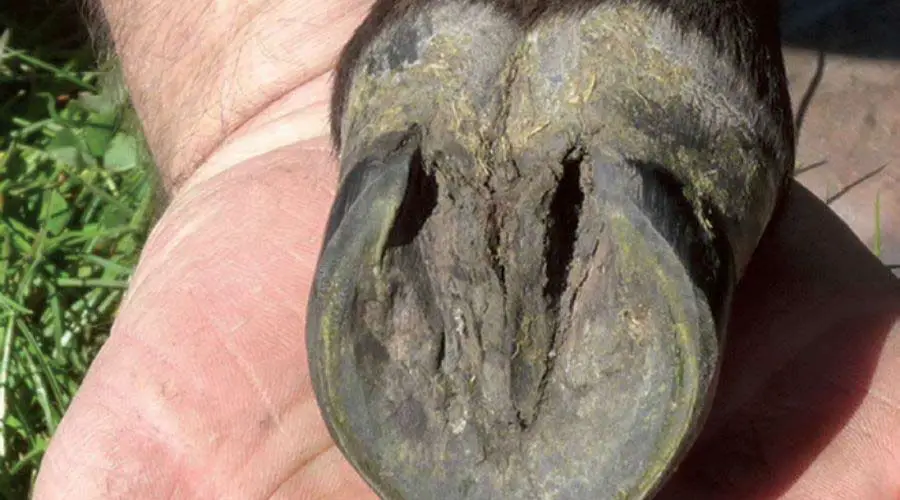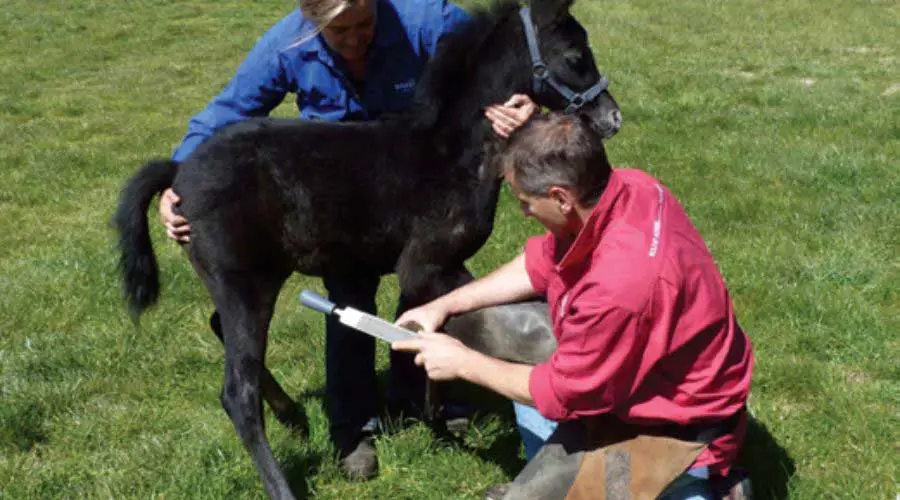Have you ever seen baby horse hooves a few moments after birth? You will be amazed at the wonders of nature! Newborn foal hooves look weird after birth, but this is completely normal.
Why do foals have weird hooves?
The main reason why a young horse has a soft hoof capsule is to aid in safe delivery.
Newborn horse hooves are called fairly finger, golden slippers, and their scientific name is eponychium. The soft hoof capsule protects the mare birth canal from sharp edges during birth. The deciduous hoof capsule starts to dry after the foal is born.
As the newborn horse starts to walk, the foal slippers fall off and they disappear within 24 – 48 hours.
Sounds mysterious, right?
While the hoof capsule looks feathery, it is made of rubbery and soft tissues. Here is essential information you need to understand about a foal hoof.
Understanding foal hoof development: what do newborn horse hooves look like?
A horse hoof undergoes many dynamic changes in its lifetime.
A baby horse is born with the soft tissue on the bottom of the hoof that covers the hoof wall and the frog. The purpose of this soft tissue in all horse breeds is to protect the mare from internal injuries when foaling.
Baby horse hooves look like feathers but they are actually rubbery and soft. Because the placenta attracts many predators, the equine species start to run away from danger right from birth. This means the newborn foal and the mare have to move away from the birth spot to escape from the predators.
When the foal slippers come into contact with air, they start to dry out and wear out when the horse starts to walk on the ground. This reveals the normal hooves you see in horses.
Apart from escaping predators, the first movement is crucial for the foal because it helps in muscle coordination, mental awareness, and spinal alignment among other changes.

Why are foals born with soft hooves?
Newborn foal hooves look mysterious after birth.
They are born with soft hooves that look like finger projections that begin to dry a few hours after birth.
The soft hooves or deciduous hoof capsule plays a crucial part during pregnancy and birth. The main role of the soft capsule is to cover the sharp edges of the untried horse hooves to provide a smooth and safe birth through the birth canal.
Foal slippers make it possible for the baby horse to be born with fully formed hooves because they protect the foal’s hooves from injuring the uterus.
Any difference between a baby horse’s and an adult horse’s hooves?
Baby horses’ hooves look similar to adult horses’ hooves in terms of design and shape. The difference is the size. However, there are some differences between a baby horse and an adult horse.
Let’s dig a little deeper!
Foals have a tighter laminae connection on the hoof that grows at a faster rate around the whole hoof. In an adult horse, the laminae grow down starting from the coronary band and resemble wild horses’ hooves. The tight connections hold the coffin bone, navicular bone, and the internal structures in the hoof capsule.
The front and the hind hooves also differ in foals and adult horses. This is because of the slow changes that take place in the hoof shape as a result of changes in the movement patterns of the horse.
Another major difference is the rate of hoof growth which goes hand in hand with the heart rate. Since baby horses have a higher heart rate than older horses, their hooves grow faster than adult horses. The rate at which a horse hoof grows decreases with age.
Problems & solutions: what can go wrong with baby horse hooves?
Horse hooves offer a good foundation for your foal, pony, or adult horse. Several things can go wrong with your baby horse hooves.
Let’s dig deeper into these problems and their solutions!
Flexor tendon flaccidity
This refers to excessive looseness deeper in the digital flexor tendon. This makes the foal stand on heel bulbs keeping the toes raised on the ground. The problem is common with very small, sick, or premature foals.
The problem mainly self-corrects itself as the muscles develop and become strong. If the problem doesn’t correct on its own, vets and farriers recommend using glue on shoes for heel extension. It can take 7-10 days to correct flexor tendon flaccidity when the foal is about 4 days old.
Angular limb deformity
This is a condition where the limb deviates at a joint rather than towards or away from the middle. It takes place when there is a faster growth rate on one side of the growth plate on top of the joint.
Before you find solutions for angular limb deformity, it is good for you and your vet to determine whether the inward or outward toe conformation results from the foot or the limb.
Flexural deformities
This is a problem that makes the deep digital flexor unit short. The solution to this problem depends on how severe the structure is.
This problem can be present at birth or when the horse is about 2-4 months. Horse owners can offer therapy like restricted exercise, bandaging, trimming, surgery, medication, and horse nutrition changes.
Foal hoof care tips
Foals develop faster within their first year of life. Taking proper care of the young horse’s foot is essential for a healthy horse hoof. At this age, foaling is crucial to prevent minor problems from becoming severe. Horse owners should examine foals right from birth throughout their growth.
Let’s have a closer look at some foal hoof care tips!
Imprint training
You should start imprint training right after birth. Do this by rubbing down the legs and then pat the hoof with your hand about 50 times on each foot until the baby horse relaxes. Repeat this process daily, weekly, and monthly.
You should also consider cleaning the foal’s feet any time you handle the horse to make him get used to foot handling.
Hoof trimming

This helps in correcting stance problems and preventing other hoof conditions like frog thrush, vertical fissures, and white line disease. If you don’t find any limb deformities, you should start hoof trimming when the foal is 4-6 weeks old.
The trimming period can vary from 6-8 weeks depending on the season. Avoid over-trimming the hooves because baby horses’ feet don’t grow a lot. You must pay special attention when cutting a horse’s hoof.
- Be gentle on weak bones.
- Educate the foal.
Read more about trimming:
- Who professionally trims hooves? Horse farrier
- What tools use for hooves trim? 5 commonly used tools
- How to prevent horse hoof bleeding after trim
Shoeing
Foals with crooked feet can use aluminum or plastic shoes to aid in weight distribution. Shoeing protects the feet from wearing out during growth and promotes a balanced stance.
Use ointments
Using ointments promotes healthy hooves and keeps them in good condition. use black ointment during wet seasons to prevent the hoof from softening. You can also use lanolin or beeswax balm to prevent cracks on the hoof horn.
Conclusion
Were you fortunate enough to see the fairy fingers before they disappeared? What was your reaction?
By now, I believe you have a better understanding of baby horse hooves. At first, you might think the fairy fingers at birth are abnormal but it is completely normal. Foals have a soft hoof capsule to protect the uterus and aid in safe delivery.
Without these soft tissues, the foal hooves can tear the mare’s birth canal leading to injuries. The feather-like structures disappear within 24 – 48 hours when the foal starts to walk. It is good to practice hoof care from birth throughout the horse’s life. Lastly, remember to give your young horse a nutritious diet for healthy hoof growth.



